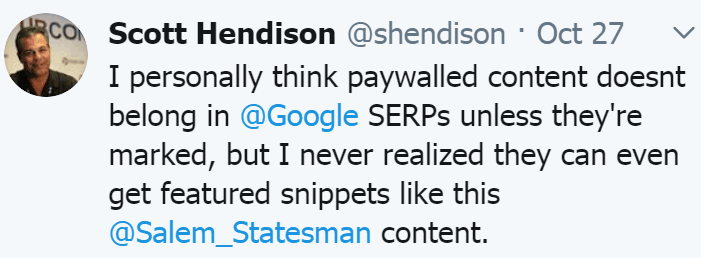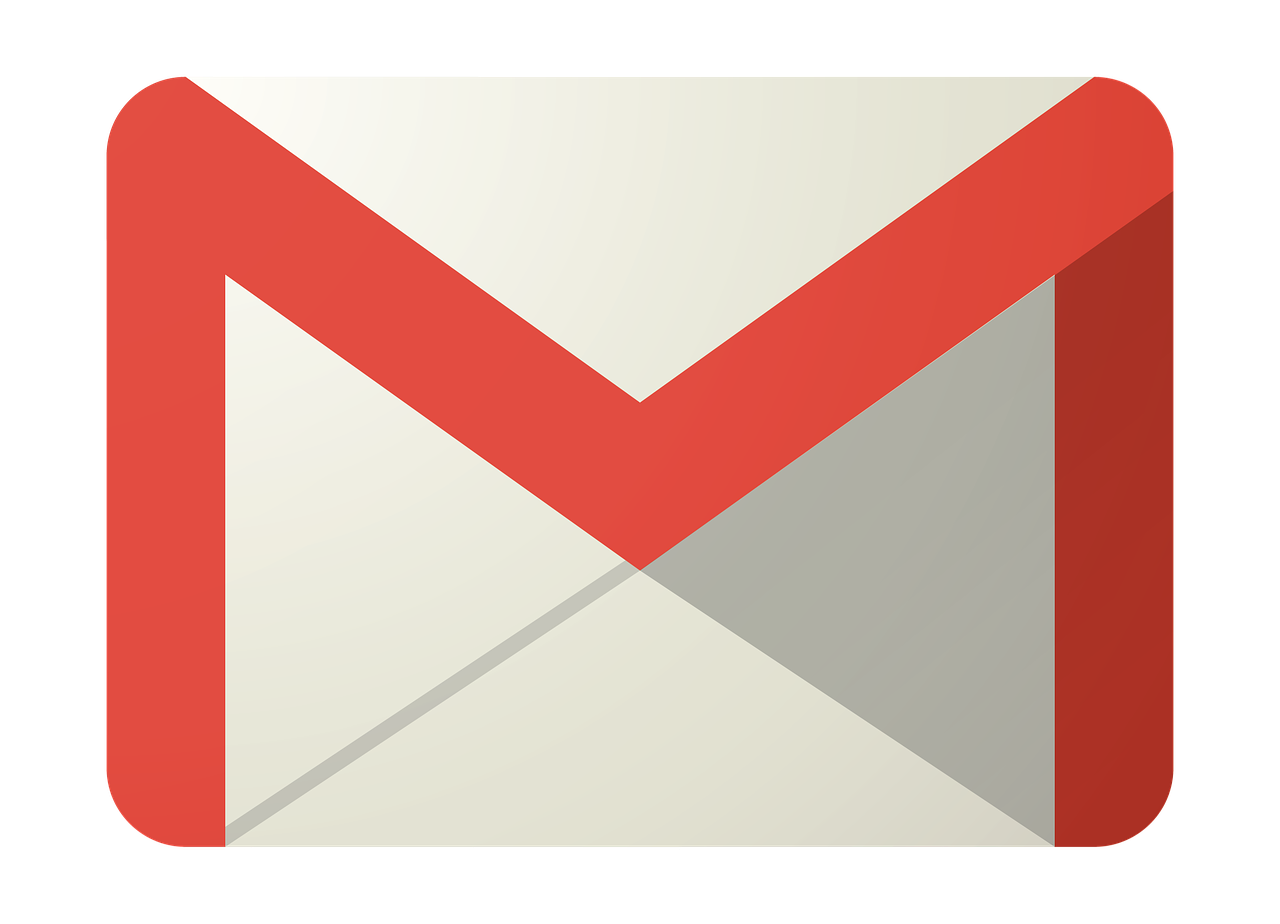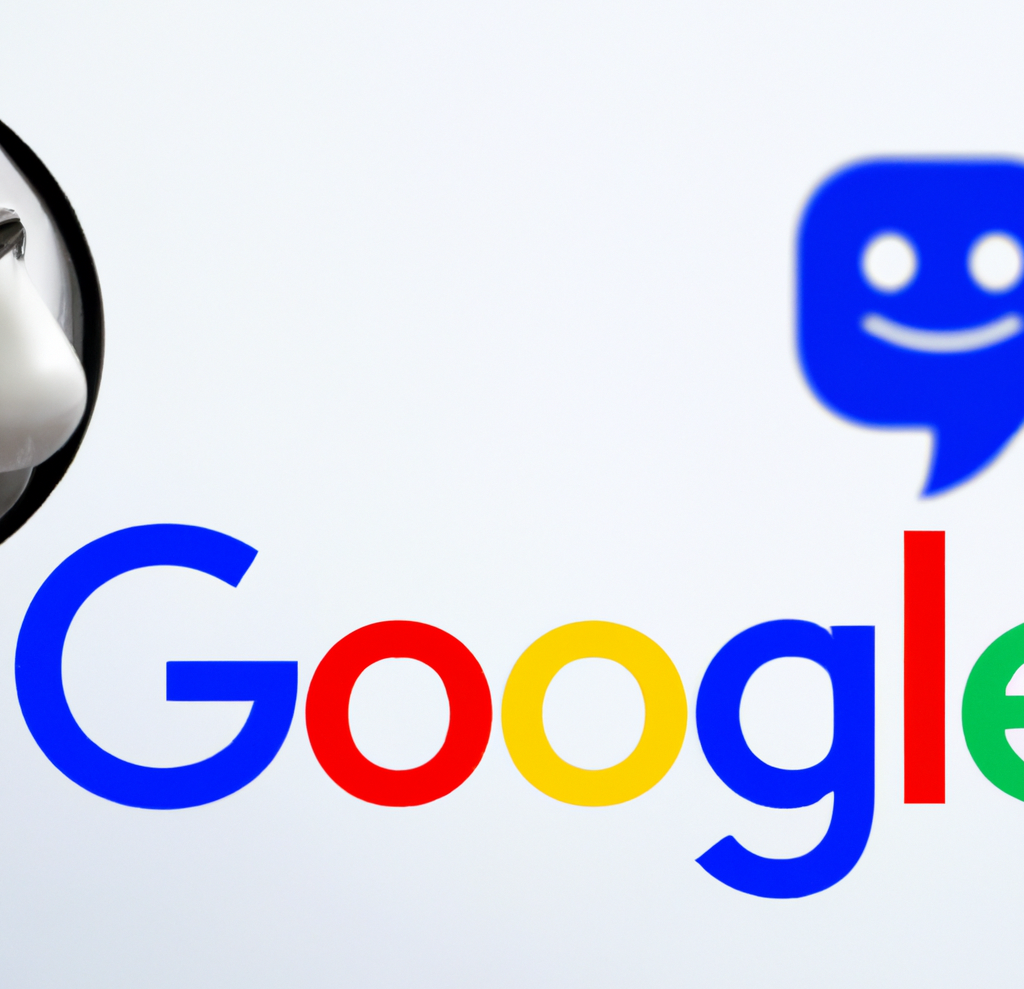Google Shows Paywall Content in Featured Snippets

A member of the search marketing community tweeted his surprise that Google ranked a paywalled web page in the featured snippets. Google’s official description of featured snippets precludes content that cannot be clicked through to be read.
But other documentation states that paywalled content is acceptable for Google Search as well as Google News. In addition to requirements for structured data that is missing, it’s unclear if this featured snippet is a mistake or if Google meant to do that.

Scott Hendison (@shendison) tweeted his opinion that paywalled content does not belong in Google search results.
“I personally think paywalled content doesnt belong in @Google SERPs unless they’re marked, but I never realized they can even get featured snippets like this
@Salem_Statesman content.”

This is a screenshot of the featured snippet that contains a paywalled web page that once clicked through does not display the content.
What is Paywalled Content?
Paywalled content is content that is available for the cost of a subscription. Only subscribers can read it.
Google shows paywalled content in Google News. The idea is that people who read the news will find value in subscribing to a newspaper to read the excellent content they are unable to see.
In Google’s Publisher Help Center Google has also said that paywalled content is allowed in Search and News.
So it appears that in fact, paywalled content is allowed to be shown in search. But there are rules that publishers are encouraged to follow.
What are the Rules for Paywalls?
According to Google, sites with Paywalls are encouraged to use structured data that indicates the content is paywalled.
Here is what Google’s official announcement from 2017 says of the structured data:
“Sites with paywalls are strongly encouraged to apply the new structured data to their pages, because without it, the paywall may be interpreted as a form of cloaking, and the pages would then be removed from search results.”
Google’s developer page for paywalled content and structured data says:
“This structured data helps Google differentiate paywalled content from the practice of cloaking, which violates our guidelines.”
Google recommends this section for the structured data that tells Google that a web page is behind a paywall:
“isAccessibleForFree”: “False”,
“hasPart”:
{
“@type”: “WebPageElement”,
“isAccessibleForFree”: “False”,
“cssSelector” : “.paywall”
That entire part of the code is “strongly encouraged” by Google to be in the structured data for paywalled content.
The news page that is ranking in Google’s featured snippets does not use the recommended structured data.
The structured data that is “strongly encouraged” is missing from the web page that is ranking in Google’s featured snippets. I visited the web page with my browser set to emulate Googlebot and reviewed the structured data the web page shows to Google. The “isAccessibleForFree” part was missing.
Additionally, according to Google’s publisher center help page, the publisher must use a “Flexible Sampling model” which allows users to sample a news page. But that may not be happening.
I visited the web page and was immediately blocked, even though I’ve never visited the web page. I checked with different browsers and I received the same message telling me I did not have access to the page. I was not allowed to sample any page. I was blocked and solicited for money.

Here is what Google’s Publisher Help Center says:
“As a result of our learning, we decided to transition from our FCF program and its fixed, free-sampling requirement to a Flexible Sampling model. Publishers determine their own optimal rate of sampling based on their ongoing experience using free samples to attract new users and using the paywall to elicit user registration or subscription.”
According to Google’s 2017 announcement, web sites are strongly encouraged to use the structured data. But that does not explicitly say they required to. Nevertheless, the Google Developer page says that web pages that lack the structured data could be removed if they are perceived as “cloaking” which is the practice of showing one page to Google and a different page to users.
Are Paywalls Supposed to be In Featured Snippets?
According to Google’s Help Center page about how featured snippets work, featured snippets are meant to be read as well as clicked so that a user can read the web pages. Google does not make an exception for paywalled web pages.

According to Google’s help page, a user is supposed to be able to click through the featured snippets and “read the page itself.”
A paywalled web page appears to be incompatible with featured snippets because a user cannot click through to read the web page.
Featured Snippets Issue is Complicated
- Paywalled content is allowed in Google Search.
- Paywalled content is does not conform with how featured snippets are supposed to work, by allowing users to click through and read the site.
- Web pages with paywalled content are strongly encouraged to use structured data to tell Google their pages are paywalled.
- But the paywalled web page in the featured snippets does not use the structured data, so that does that mean it’s presence is a mistake?
Lost in the confusion is the user experience. How do you feel about it? Should Google featured snippets allow paywalled content?
AI
Exploring the Evolution of Language Translation: A Comparative Analysis of AI Chatbots and Google Translate

According to an article on PCMag, while Google Translate makes translating sentences into over 100 languages easy, regular users acknowledge that there’s still room for improvement.
In theory, large language models (LLMs) such as ChatGPT are expected to bring about a new era in language translation. These models consume vast amounts of text-based training data and real-time feedback from users worldwide, enabling them to quickly learn to generate coherent, human-like sentences in a wide range of languages.
However, despite the anticipation that ChatGPT would revolutionize translation, previous experiences have shown that such expectations are often inaccurate, posing challenges for translation accuracy. To put these claims to the test, PCMag conducted a blind test, asking fluent speakers of eight non-English languages to evaluate the translation results from various AI services.
The test compared ChatGPT (both the free and paid versions) to Google Translate, as well as to other competing chatbots such as Microsoft Copilot and Google Gemini. The evaluation involved comparing the translation quality for two test paragraphs across different languages, including Polish, French, Korean, Spanish, Arabic, Tagalog, and Amharic.
In the first test conducted in June 2023, participants consistently favored AI chatbots over Google Translate. ChatGPT, Google Bard (now Gemini), and Microsoft Bing outperformed Google Translate, with ChatGPT receiving the highest praise. ChatGPT demonstrated superior performance in converting colloquialisms, while Google Translate often provided literal translations that lacked cultural nuance.
For instance, ChatGPT accurately translated colloquial expressions like “blow off steam,” whereas Google Translate produced more literal translations that failed to resonate across cultures. Participants appreciated ChatGPT’s ability to maintain consistent levels of formality and its consideration of gender options in translations.
The success of AI chatbots like ChatGPT can be attributed to reinforcement learning with human feedback (RLHF), which allows these models to learn from human preferences and produce culturally appropriate translations, particularly for non-native speakers. However, it’s essential to note that while AI chatbots outperformed Google Translate, they still had limitations and occasional inaccuracies.
In a subsequent test, PCMag evaluated different versions of ChatGPT, including the free and paid versions, as well as language-specific AI agents from OpenAI’s GPTStore. The paid version of ChatGPT, known as ChatGPT Plus, consistently delivered the best translations across various languages. However, Google Translate also showed improvement, performing surprisingly well compared to previous tests.
Overall, while ChatGPT Plus emerged as the preferred choice for translation, Google Translate demonstrated notable improvement, challenging the notion that AI chatbots are always superior to traditional translation tools.
Source: https://www.pcmag.com/articles/google-translate-vs-chatgpt-which-is-the-best-language-translator
Google Implements Stricter Guidelines for Mass Email Senders to Gmail Users

Beginning in April, Gmail senders bombarding users with unwanted mass emails will encounter a surge in message rejections unless they comply with the freshly minted Gmail email sender protocols, Google cautions.
Fresh Guidelines for Dispatching Mass Emails to Gmail Inboxes In an elucidative piece featured on Forbes, it was highlighted that novel regulations are being ushered in to shield Gmail users from the deluge of unsolicited mass emails. Initially, there were reports surfacing about certain marketers receiving error notifications pertaining to messages dispatched to Gmail accounts. Nonetheless, a Google representative clarified that these specific errors, denoted as 550-5.7.56, weren’t novel but rather stemmed from existing authentication prerequisites.
Moreover, Google has verified that commencing from April, they will initiate “the rejection of a portion of non-compliant email traffic, progressively escalating the rejection rate over time.” Google elaborates that, for instance, if 75% of the traffic adheres to the new email sender authentication criteria, then a portion of the remaining non-conforming 25% will face rejection. The exact proportion remains undisclosed. Google does assert that the implementation of the new regulations will be executed in a “step-by-step fashion.”
This cautious and methodical strategy seems to have already kicked off, with transient errors affecting a “fraction of their non-compliant email traffic” coming into play this month. Additionally, Google stipulates that bulk senders will be granted until June 1 to integrate “one-click unsubscribe” in all commercial or promotional correspondence.
Exclusively Personal Gmail Accounts Subject to Rejection These alterations exclusively affect bulk emails dispatched to personal Gmail accounts. Entities sending out mass emails, specifically those transmitting a minimum of 5,000 messages daily to Gmail accounts, will be mandated to authenticate outgoing emails and “refrain from dispatching unsolicited emails.” The 5,000 message threshold is tabulated based on emails transmitted from the same principal domain, irrespective of the employment of subdomains. Once the threshold is met, the domain is categorized as a permanent bulk sender.
These guidelines do not extend to communications directed at Google Workspace accounts, although all senders, including those utilizing Google Workspace, are required to adhere to the updated criteria.
Augmented Security and Enhanced Oversight for Gmail Users A Google spokesperson emphasized that these requisites are being rolled out to “fortify sender-side security and augment user control over inbox contents even further.” For the recipient, this translates to heightened trust in the authenticity of the email sender, thus mitigating the risk of falling prey to phishing attempts, a tactic frequently exploited by malevolent entities capitalizing on authentication vulnerabilities. “If anything,” the spokesperson concludes, “meeting these stipulations should facilitate senders in reaching their intended recipients more efficiently, with reduced risks of spoofing and hijacking by malicious actors.”
Google’s Next-Gen AI Chatbot, Gemini, Faces Delays: What to Expect When It Finally Launches

In an unexpected turn of events, Google has chosen to postpone the much-anticipated debut of its revolutionary generative AI model, Gemini. Initially poised to make waves this week, the unveiling has now been rescheduled for early next year, specifically in January.
Gemini is set to redefine the landscape of conversational AI, representing Google’s most potent endeavor in this domain to date. Positioned as a multimodal AI chatbot, Gemini boasts the capability to process diverse data types. This includes a unique proficiency in comprehending and generating text, images, and various content formats, even going so far as to create an entire website based on a combination of sketches and written descriptions.
Originally, Google had planned an elaborate series of launch events spanning California, New York, and Washington. Regrettably, these events have been canceled due to concerns about Gemini’s responsiveness to non-English prompts. According to anonymous sources cited by The Information, Google’s Chief Executive, Sundar Pichai, personally decided to postpone the launch, acknowledging the importance of global support as a key feature of Gemini’s capabilities.
Gemini is expected to surpass the renowned ChatGPT, powered by OpenAI’s GPT-4 model, and preliminary private tests have shown promising results. Fueled by significantly enhanced computing power, Gemini has outperformed GPT-4, particularly in FLOPS (Floating Point Operations Per Second), owing to its access to a multitude of high-end AI accelerators through the Google Cloud platform.
SemiAnalysis, a research firm affiliated with Substack Inc., expressed in an August blog post that Gemini appears poised to “blow OpenAI’s model out of the water.” The extensive compute power at Google’s disposal has evidently contributed to Gemini’s superior performance.
Google’s Vice President and Manager of Bard and Google Assistant, Sissie Hsiao, offered insights into Gemini’s capabilities, citing examples like generating novel images in response to specific requests, such as illustrating the steps to ice a three-layer cake.
While Google’s current generative AI offering, Bard, has showcased noteworthy accomplishments, it has struggled to achieve the same level of consumer awareness as ChatGPT. Gemini, with its unparalleled capabilities, is expected to be a game-changer, demonstrating impressive multimodal functionalities never seen before.
During the initial announcement at Google’s I/O developer conference in May, the company emphasized Gemini’s multimodal prowess and its developer-friendly nature. An application programming interface (API) is under development, allowing developers to seamlessly integrate Gemini into third-party applications.
As the world awaits the delayed unveiling of Gemini, the stakes are high, with Google aiming to revolutionize the AI landscape and solidify its position as a leader in generative artificial intelligence. The postponed launch only adds to the anticipation surrounding Gemini’s eventual debut in the coming year.
-

 PPC4 days ago
PPC4 days ago19 Best SEO Tools in 2024 (For Every Use Case)
-

 MARKETING7 days ago
MARKETING7 days agoWill Google Buy HubSpot? | Content Marketing Institute
-
SEARCHENGINES7 days ago
Daily Search Forum Recap: April 16, 2024
-

 SEO7 days ago
SEO7 days agoGoogle Clarifies Vacation Rental Structured Data
-

 MARKETING6 days ago
MARKETING6 days agoStreamlining Processes for Increased Efficiency and Results
-
SEARCHENGINES6 days ago
Daily Search Forum Recap: April 17, 2024
-

 PPC7 days ago
PPC7 days agoHow to Collect & Use Customer Data the Right (& Ethical) Way
-

 SEO6 days ago
SEO6 days agoAn In-Depth Guide And Best Practices For Mobile SEO















